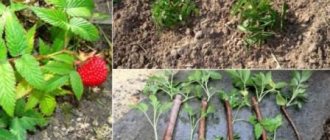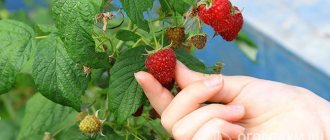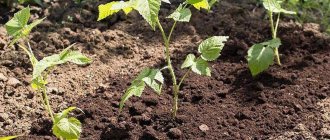Caramel belongs to the remontant raspberry varieties. She deservedly received her delicious name. The fruits of this raspberry are extremely sweet - it was recognized as the most delicious among the remontant varieties. Let's find out how to plant Caramel and how to care for it.
raspberry variety "Caramel"
raspberries “Caramel” have an appetizing presentation
variety "Caramel" is considered one of the most successful new products in the remontant category
Description of Caramel
Brief botanical description of the Caramel variety:
- Bushes. Erect, medium height. Height – 1.5-1.7 m. Shoots are straight, of normal thickness, with sharp and soft thorns.
- Leaves. Green, slightly wrinkled, slightly pubescent.
- Fruit. Large, dry, shiny, red. The shape is wide-conical. The average weight is 6 g, the largest berries reach 12 g. The berries are easily separated when ripe and do not soften. The taste of the fruits resembles wild raspberries.
Description and characteristics
Caramel is a new product among remontant (those in which both annual and biennial shoots bear fruit 2-3 times a year) raspberry varieties.
The Caramel variety can be recognized by the following description:
- the stems of the bushes have an average height that does not exceed 1.5 m, the growth of the stems is even and uniform, which forms an erect bush;
- due to the density of the shoots, there is no need to tie up the bush;
- the surface of the raspberry stems is covered with small, soft needles, which does not cause any inconvenience for the gardener in caring for and harvesting;
- the foliage of the variety has an oval shape, elongated at the edges and bordered with cloves;
- You can distinguish a young shoot from an old one by the green color of the stems and the waxy coating on the former. With the onset of autumn, the shoots turn purple;
- The fruits of the variety have a wide conical shape and are light red in color and glossy. The weight of raspberries ranges from 3.8–8 g.
Characteristics of the variety
Caramel raspberries are especially appreciated by gardeners from risky farming areas. This variety is capable of quickly forming annual shoots and bearing fruit intensively over a not too extended period. The variety does not require winter shelter, and most of the berries have time to ripen before frost, even in regions with short summers.
The fruits of Caramel ripen simultaneously on one-year and two-year branches.
Experts advise growing Caramel in an annual crop. This is especially true in regions with long, cold winters. The variety belongs to the mid-early variety. In the middle zone, berry picking begins at the end of July. Characteristics of the Karamelka variety are in Table 1.
Table 1
| Options | Description |
| Fruiting | remontant |
| Productivity | 5 kg per bush, 15 kg per 1 ha |
| Tasting score | 4.6 out of 5 |
| Purpose | universal |
| Shoot formation activity | average |
| Transportability | good |
| Frost resistance | high |
| Drought resistance | satisfactory |
| Growing regions | throughout the country, including the Far East and Kamchatka |
Expert answer: why raspberries grow together Caramel
The phenomenon of berry fusion is characteristic not only of Caramel raspberries. There are two reasons for this: excess moisture and viral diseases. The berries get microcracks when pouring and grow together into one.
Raspberries of this variety grow together, most likely, for the first reason, since they have good immunity to diseases. But many have heard about its low drought resistance. Therefore, irregular watering, as well as violation of water volume standards (excessive waterlogging) can cause the berries of Caramel raspberries to grow together.
A short video about Caramel raspberries will tell you in more detail about the variety
Where to buy and how to choose seedlings?
In order for planted seedlings to grow into varietal raspberries that meet the stated characteristics, planting material from reliable sources is needed. These include specialized nurseries professionally engaged in the cultivation of berry crops, as well as their sales offices.
A video review of the “Caramel” raspberry variety is presented below:
How to choose the right healthy sample?
The future productivity of the berry garden depends on the health and development of the seedlings. When buying planting material, pay attention to the appearance of each seedling:
- Recommended height: 30 cm.
- The main point is the roots. They should be fibrous, consisting of many thin roots. If the seedling has thick, bare roots, it will take a long time to take root and will grow slowly. A high-quality seedling should also have the beginnings of young shoots.
- The presence of dry leaves that are difficult to tear off indicates a violation of harvesting rules or insect damage.
- Seedlings from last year should not show any traces of mold or disease - they may be indicated by dark or light spots covering the bark.
- It is desirable that the roots of the seedling are in the substrate.
Inexperienced gardeners, when buying raspberries for planting, are tempted by seedlings with lush green foliage. They look tempting, but in reality they are worthless material. If you take seedlings in the spring and they have leaves, there is a risk that they have not overwintered correctly. The presence of greenery also indicates that the plant has spent energy on growing leaves - because of this, in the first year of planting, it may not even bloom.
Choose short, unsightly seedlings with a lush root system for planting, rather than powerful leafy counterparts with thick roots.
Planting process
Prepare holes up to 40 cm deep and 60 cm wide.
In each of them put 2 tbsp. spoons of superphosphate and mix it with the soil. They also add organic matter (humus, compost or peat).
The shoots of each seedling are shortened to 30 cm, and then placed in a hole, the root system is leveled and sprinkled with soil.
Then watering is carried out. It will compact the soil around the bush and prevent the formation of voids.
After the soil settles, add it, and at the same time make sure that the root collar of each plant is at ground level.
Advantages and disadvantages
Advantages of the “Caramel” variety:
- Due to the dense pulp, the fruits tolerate transportation well and retain freshness for a long time.
- High frost resistance.
- The bushes are straight, with thick stems - they do not need support.
- Small number of thorns.
- Delicious and sweet berries.
- Good yield.
- Good indicators of shoot formation - produces 7-8 replacement shoots. Seedlings planted in spring produce a lot of berries already in the summer of the first year.
- High marketability.
- The variety is convenient for planting industrial plantings, since gaps of 1 m are left between Caramel seedlings, and 0.6-0.8 m for other varieties.
- Unpretentiousness, endurance and high immunity.
- The berries are suitable for freezing.
- The crop can be harvested using mechanical devices.
- Resistance to temperature fluctuations.
The variety has few disadvantages:
- Weak to moderate drought resistance.
- Late ripening of the second harvest.
- The actual yield turns out to be less than stated.
Site preparation
One of the main criteria when choosing a place for planting is that raspberries absolutely cannot be planted in the soil if raspberries of a different variety have been growing in this place for more than 7 years. Such soil is considered depleted. In addition, you cannot plant bushes in the place where potatoes, peppers, eggplants, and tomatoes grew before the raspberries. These crops and raspberries have common diseases and pests. Therefore, it can become infected from its predecessors through the soil.
Unlike simple raspberries, remontant caramel needs to absorb more nutrients and microelements, so the soil for it must be fertile and loose in order to allow moisture and air to pass through well. The ideal option would be loamy or sandy soil.
The soil for planting caramel should be prepared in the fall if the seedlings are planned to be planted in the spring. And vice versa, if you plan to plant in the fall, then the soil needs to be prepared in the spring. Preparation should be carried out according to the planting rules:
- The soil in the area for planting raspberries must be dug up. In this case, you should immediately remove weeds and plant roots from the soil;
- You need to sow green manure into the dug up soil. They can be mustard, phacelia or pea mixtures. After which the ground needs to be dug up again;
- on light and medium-level loams, it is necessary to add the necessary fertilizers to the soil.
According to the description of the caramel raspberry variety and reviews from gardeners, fertilizers must be applied to the soil in a comprehensive manner.
For 1 sq. m of soil must be added:
- 20 kg of humus or peat;
- 200 g of superphosphate, 180 g of nitroammophosphate, or 250 g of potassium sulfate (all three fertilizers to choose from).
Subtleties of landing
Caramel is planted in the spring - in March, or in September-October. Autumn planting has its advantages - raspberries have time to take root and enter spring prepared for the growing season. Recommended dates are from September 20 to October 15.
Recommended and unsuitable "neighbors"
When planting raspberries, the neighborhood and predecessors are taken into account. Raspberries are not recommended to be grown next to plants that compete for nutrients and moisture. It also cannot be placed next to aggressive crops or sources of toxic substances for raspberries.
Unwanted neighbors:
- grape;
- elder;
- sea buckthorn;
- jasmine;
- flowers – iris, marigolds, nasturtium.
Garlic, radishes and parsley are crops that prevent the growth of raspberries.
The best neighbors for raspberries:
- barberry;
- digitalis;
- strawberry;
- Red Ribes;
- greens – sorrel, basil, dill;
- flowers – asters, delphinium;
- vegetables - cucumbers, tomatoes, peas, carrots, celery.
Favorable predecessors for Caramel are peppers, tomatoes, potatoes. It cannot be planted after another raspberry - the soil is restored within 5-7 years.
Soil preparation
Raspberries are planted in a well-lit area. It is desirable that there be protection from the wind on the north side - for example, a wall of a house, a fence, a planting. Raspberries are planted on the south side of the site. She loves loose, well-permeable soils, without excess moisture.
The soil for planting is prepared at least 2-3 weeks before planting the seedlings. The site is dug up, adding fertilizers and adjusting the composition of the soil. For 1 sq. m contribute:
- compost or humus - 2-3 buckets;
- superphosphate – 50-60 g;
- potash fertilizers – 30-40 g.
If the soil is clayey or heavy, additionally add half a bucket of coarse sand for each square meter. Acidic soils are deoxidized with lime or old cement. Instead of potassium-phosphorus fertilizers, you can add wood ash.
Planting methods
Caramel raspberries are planted in one of the following ways:
- Bush. Dig round holes of suitable depth and diameter. Each hole is filled with humus mixed with fertilizers. The holes are placed equidistant from each other - at a distance of 50-70 cm.
- Trench. Dig a trench 50-55 cm wide. Here, observing a certain interval, seedlings are placed. The distance between trenches is 2 m.
- Tape. Raspberries are planted in rows. They dig holes in which the seedlings are placed at a distance of 50-80 cm from each other. With this method of planting, it is convenient to tie the bushes to trellises. The length of the rows is any. Makes harvesting and caring for plants easier. Unlike the trench method, not one row, but several are planted in pits. Therefore, the width of the pit is greater than with the trench method - about 1 m.
- Curtinny. Used for weakened seedlings. 3-4 seedlings are placed in one hole. Bushes can be arranged in rows or in squares.
- Triangular. Often used for remontant varieties. The triangle is equilateral. Between seedlings - 50 cm.
The Karamelka variety is productive, so the shoots tend to sag under the weight of the fruit. To prevent shoots from falling, it is recommended to tie raspberries on trellises.
Step-by-step instructions for planting in open ground
The recommended planting pattern is 2 rows. Between seedlings - 50-70 cm. Distance between rows - 1.5 m. Per 1 sq. m, no more than 4-5 bushes are planted, otherwise the plantings will be thickened, which will lead to the development of diseases. For autumn planting, seedlings with a well-developed root system are used.
Stages of planting raspberries:
- Dig holes. The depth of the holes is 50-60 cm. The width is similar.
- Pour 4-5 kg of humus into each hole to stimulate the roots and increase productivity.
- Add to the humus - for each hole, 2 tbsp. l. superphosphate.
- Shorten the seedlings to 25-30 cm.
- Sprinkle a little nutritious soil on the humus so that the seedling does not burn the roots.
- Form a hill from the soil poured into the hole. Place the roots of the seedling on it, carefully straightening them.
- Cover the roots of the seedling with soil, tamping it with your hands from time to time so that there are no voids.
- Water the seedling. The watering rate is half a bucket per bush. Even when it rains, watering is necessary.
- When the water is absorbed, sprinkle the soil with 3-4 cm of humus, peat, or other mulch.
When planting, make sure that the root collar is level with the ground surface - it cannot be buried.
Landing
Remontant varieties are unpretentious, but for repeated flowering and fruiting they require a lot of sunlight, so they are usually planted in areas with maximum lighting. The distance between seedlings is left up to 70 cm; with industrial cultivation it increases to 1 meter.
Light, fertile soils are chosen for planting. It is advisable to choose a place on the south side of the building with good lighting and protection from winds. There should be from 3 to 5 plants per square meter.
Raspberries are planted in March and September. In the spring, small green shoots are rooted, and in the fall, one-year-old cuttings with an already developed root system are prepared. Moreover, a plant planted in the fall will be able to take root better in the soil. The area intended for raspberries is first dug up and fertilized.
Note! If you buy planting material, inspect the seedlings for damage and disease. The presence of dry leaves indicates that the plant did not overwinter properly.
Caring for raspberries Caramel
The quality of care determines the yield of Caramel, the taste and sweetness of its fruits. The Caramel variety, in addition to standard care, requires mandatory garter.
Top dressing
Caramel bears fruit for a long time, so it is fed three times during the season. The feeding scheme is in Table 2.
table 2
| Period | Composition and norms of fertilizing |
| After the end of spring frosts | For 1 sq. m add 5 liters of solution:
Instead of organic matter, you can add mineral fertilizers - ammonium nitrate and urea (15 g per 1 sq. m). |
| Bloom | For a bucket of water - 20 g of potassium salt and superphosphate. This amount is enough for 1 sq. m. |
| After picking berries | Add compost or manure. Under one bush - a bucket. |
Fertilizing is never applied to dry soil - you can burn the roots. Before applying fertilizer, the soil must be watered.
Regularity of watering
Raspberry Caramel needs regular watering. Plantings are watered by sprinkling or at the root. The amount of water for irrigation depends on soil moisture and weather. The average watering rate is 2 buckets per bush. Do not water raspberries when it rains. The usual frequency of watering raspberries is once every half month.
Rules for gartering and trimming
Raspberries are pruned in different seasons:
- In autumn. Annual shoots are pruned, leaving stumps 3 cm high. Thanks to pruning, the future harvest increases, and viruses and parasites that overwinter on the shoots are destroyed. You can get more information about pruning raspberries in the fall here.
- In the spring. Dried or frozen shoots are selectively pruned. Pruning begins around April - when the health and viability of the plant can be judged by the condition of the buds.
- In summer. In June, weak stems and root shoots are removed. For 1 sq. m leave 5-6 powerful stems. Excess shoots are cut off with pruning shears.
Caramel stems are elastic and strong, but it is recommended to tie them up - thanks to the tie, the plantings are well ventilated and easy to maintain. Caramel shoots are tied onto trellises - these are wires stretched between two posts.
Preventative treatment
Good growth and development depends on the timeliness of preventive measures. Raspberry plantings need:
- Trim on time. All pruned shoots, as well as fallen leaves, are collected and disposed of.
- Spray with fungicides and insecticides. Raspberries are treated with Bordeaux mixture, HOM, copper sulfate, Actellik, and Karate.
- It is important to regularly inspect the bushes in order to detect disease or parasite damage in time.
Preparing for winter
Preparing Caramel raspberries for winter:
- Pruning and destruction of cut branches, collecting and burning leaves.
- If the raspberries are pruned at the root in the fall, then there is no need to cover them. It is enough to sprinkle the soil with a layer of mulch to protect the root system. Read more about soil mulching here.
- If annual shoots are left for the winter, then preparation for wintering is carried out according to the standard scheme. Before the onset of frost, the shoots are bent to the ground and fixed so that in winter they are completely under the snow cap. To keep the stems near the ground, they are tied into bunches and pinned with metal staples.
Features of planting and growing
The harvest of the crop depends on how correctly the area for raspberries is chosen, the health of the seedlings and the planting algorithm. This variety is considered quite capricious in terms of planting and care, so all work must be done in a timely manner and with due diligence.
How to choose a place in the garden
- In gardens located in the central zone of the country, well-lit, elevated places in the garden are allocated for raspberries.
- In the south, it is allowed to plant raspberry bushes in partial shade.
To protect against cold winds, raspberries are usually placed along the fence or next to buildings.
Important! Raspberries should not be planted on low terrain. Such places are flooded after snowmelt and summer precipitation, which is detrimental to the roots.
Bad predecessors for raspberries:
- tomatoes;
- raspberries;
- pepper;
- strawberries
Loose, fertilized soil with a neutral soil solution reaction is suitable for Caramel. It is not advisable to place next to raspberries:
- sea buckthorn;
- grape;
- parsley
Disembarkation dates
Caramel can be planted in spring and autumn:
- In spring , you need to wait until positive temperatures set in during the week. With this period of time, the seedlings quickly take root, grow shoots and leaves. By autumn they will begin to bear fruit.
- In autumn . Experienced gardeners often plant raspberries in the fall, about 3 weeks before the onset of frost. This period is chosen so that the seedlings have time to take root before the cold season, and with the onset of spring, they will grow new shoots and form a decent harvest.
Where and what seedlings to buy
Quality seedlings should be purchased from garden centers or nurseries. At the time of purchase, the seedling is inspected. Roots and stems must be completely healthy, without rot or damage.
Attention! If possible, it is better to buy seedlings in containers. They are planted with a ball of earth, which is the key to good survival.
Landing algorithm
The work is performed in the following sequence:
20 days before planting, the site is dug up and weeds with roots are selected.
For digging the following is added per 1 m²:
- humus - 2 buckets;
- superphosphate – 52 g;
- potassium nitrate – 32 g.
Landing can be done in 2 ways:
- tape - used when many seedlings are planted. Prepare trenches 50 cm wide and deep. 1.5 m is maintained between rows, the planting step is taken to be 0.7 m.
- The bush method involves digging holes 50 cm in size and planting plants at a distance of 1 m from each other.
Planting stages:
- They dig holes.
- The roots of seedlings are immersed on the day of planting for 1 hour in Kornevin solution for rapid root regrowth.
- The soil mixture is poured into the hole, forming a mound.
- They place a seedling on a hill, straightening its roots.
- Cover the roots with soil, avoiding any voids.
- 5 liters of water are poured onto each plant.
- Shorten the shoots, leaving 30 cm.
- After irrigation, mulch the soil with a layer of straw.
Important! When planting in autumn, the root collar is deepened by 2 cm; when planting in spring, it should be flush with the ground.
Diseases and pests
Raspberry Caramel is resistant to most berry diseases, but if conditions favorable for viruses and fungi are created, as well as in the absence of preventive spraying, it can get sick. This also applies to pests - when the bush thickens, lack of pruning, dampness and other unfavorable factors.
Diseases and pests for the Karamelka variety, as well as measures to combat them, are in tables 3 and 4, respectively.
Table 3
| Diseases | Symptoms | How to fight? |
| Anthracnose | Gray spots with a purple border appear on the stems. | Diseased shoots are removed and burned. Spray before flowering with copper oxychloride or copper sulfate. Fertilizing with phosphorus-potassium fertilizers. |
| Rust | There are small yellow and orange spots on the shoots and leaves. | Treatment with Bordeaux mixture 1% (before flowering, two weeks, after harvest). |
| White spot | Brown spots appear on leaves and stems. The affected areas then turn white and become covered with black spots. | Before flowering begins, spray Bordeaux mixture with 1% (per 1 liter - 10 g). Spraying with HOM (40 g per bucket). Consumption – 1.5 l per 10 sq. m. |
| Bacterial cancer | The growth of the bushes slows down, the taste of the berries deteriorates. New growths up to 5 cm in size appear on the roots. | Disinfection of roots by immersion in a solution of copper sulfate (100 g per 10 liters of water). Treatment time - 5-10 minutes. |
Table 4
| Pests | Harm caused | How to fight? |
| Aphid | Leaf blades are deformed. | Spraying before flowering and after picking berries with Actellik and Karate. |
| Raspberry moth | Oviposition occurs in inflorescences. Damage to the ovaries. | Spraying with Fastak (per 10 l - 3 ml of the drug). |
| Raspberry mite | Leaves affected by mites become deformed. | Destruction of affected shoots. Treatment with Coromite (Japanese tick medicine). |
| Raspberry beetle | The larvae eat the fruits. | In May, spray with Karate (4 ml of the drug per 10 liters of water). |
When, how and where to plant Caramel raspberries
If bushes are planted in the autumn, then this is done from September to October, since in a later period it may not have time to take root in a new place. Spring planting takes place in early March, after the snow melts.
The basic rules for planting remontant raspberries are quite applicable to Caramel. The official description of the variety requires that plants be planted at a distance of at least one meter from each other.
In practice, experienced gardeners prefer to plant it using the row method with a distance of 80 cm between each bush and 120 cm between rows.
The same applies to choosing a landing site. This remontant raspberry prefers sunny areas with loose and fertile soil.
More on the topic: Standard raspberries of the Glen Ampl variety
The best place for the variety is the south side of the garden without tall plantings and buildings around the perimeter. It is very important that their shadow does not fall on the raspberry plantings during the day. Even a slight lack of sun and heat can lead to loss of yield!
The ideal site for Caramel raspberries in all respects is the one where the snow cover melts early. Most often this happens on small hills and soils well fertilized with manure or peat.
Summer residents who have already become acquainted with the “Caramelka” variety note that on highly fertile soils the bushes can grow up to 2 m in height, while becoming unstable to gusts of wind.
How to propagate the variety?
Caramel can be propagated by seedlings or cuttings. The latter method is used if there is a shortage of planting material. Propagation by cuttings:
- Cut the shoots and divide them into cuttings 25-30 cm long. There should be 3-4 buds on one cutting.
- Place the lower part of the cutting in Kornevin or another stimulant for a couple of hours.
- Plant the cuttings in a moist substrate. Cover with a glass container - you will remove it during watering and to ventilate the plant.
- When leaves and shoots appear on the cuttings, transplant them to a permanent place.
Remontant varieties produce few shoots, so for propagation you can use cutting stems from the center of two-year-old bushes. This is done in spring or autumn. Next season, the raspberries will produce new shoots suitable for planting.
Reproduction methods
Remontant yellow caramel raspberries propagate easily and there are several effective ways to do this:
- Dividing the bush. You need to select an adult bush with a powerful root system and divide it into several parts. Each division should have 2-3 strong shoots. Then the seedlings should be transplanted to a permanent place of growth and watered.
- Root suckers. Layers grow from the roots approximately 30 cm from the mother bush. Throughout the summer, you can dig up short shoots of 10-15 cm with roots and transplant them to another place.
- Green cuttings. In June, cuttings 10–15 cm long are cut from the shoot and kept for 12 hours in a growth stimulator. Then they are planted in the ground and covered with film for rooting. Plantings are periodically ventilated and watered. In autumn they are transplanted into open ground.
Propagation of raspberry bushes by dividing the bush
Harvesting and transportation
The berries begin to ripen at the end of July. It is better to pick raspberries after lunch. Caramel ripens gradually, so the pink berries are not picked - they are left to ripen. Remove the berries carefully, without squeezing them with your fingers.
If the berry does not break off immediately, do not use force - let it ripen.
Place the raspberries in the container in which they will be stored or transported - it is not advisable to transfer the raspberries. Caramel fruits are dense and tolerate transportation well.
Protection of the Caramel variety from pests
The most dangerous insects for raspberries are the raspberry beetle, bud moth, and raspberry aphid. Folk remedies can be used against them, but targeted drugs remain the most effective.
It is advisable to pre-treat the bushes to prevent the appearance of pests.
Raspberry Caramel is suitable for fresh consumption, can be stored in the refrigerator for up to three days and is suitable for transportation. The berries are also used to make preserves, jams, compotes and juices.
Reviews from gardeners about Caramel
★★★★★
Andrey I., Omsk. This remontant variety turned out to be good as an annual crop.
In the fall I cut off all the stems at the root. Shoots that grow in the spring begin to bear fruit in July. The first berries were immediately very large, 3.5 cm long. I especially like the taste of the berries - they are very sweet, reminiscent of wild raspberries. ★★★★★
Kristina R., Tula region. Caramel is my favorite variety.
The berries are excellent in taste, do not get crushed during transportation - they are good for trading. The variety is unpretentious; if sprayed on time, it does not get sick, is productive and winter-hardy, and does not freeze in the coldest winters. Hide
Add your review
To take advantage of the remontant Caramel raspberry, you will have to create favorable conditions for it. Although this variety is hardy, it is extremely sensitive to growing conditions. Regular watering, fertilizing, pruning and spraying will allow you to enjoy the taste of sweet raspberries from July until late autumn.
0
0
Copy link
Reviews
The variety of red-fruited remontant raspberry “Caramelka” is erect, slightly thorny. The berries are large up to 12g, average 6g, yield up to 5kg per bush and up to 20t/ha. The taste is sharply different from the remontant raspberry varieties that exist today; the berry is VERY sweet, with the aroma of wild raspberries, the pulp is juicy, and the stem comes off easily. The berries are dense, dry, transportable. The first berries in the Nizhny Novgorod region ripen in 2013 on August 1, in 2014 on July 24. Before frost, 90% of the harvest is delivered. The variety is ideal for both private and industrial gardening. Due to the high degree of shoot formation, it produces the first harvest in the year of planting. Creates a fruit wall and the first commercial harvest in the second year of planting. To start an industrial garden, you can plant every 1 m in a row, that is, 3300 pcs/ha; when planting a garden, other varieties of Russian selection are recommended to be planted every 0.5 m in a row, or 6600 pcs/ha, and Polish varieties that will clog Russian gardens are recommended to be planted 20,000/ha. Thus, the Karamelka variety, when growing a berry garden industrially, allows you to reduce the cost of planting a garden by at least half; the cost of planting material during planting is 70-80% of the total starting costs. And the first harvest in the year of planting and the first commercial one in the second year after planting accelerates the payback of the berry farm by 1-2 years. In the spring of 2015, the nursery plans to release the new variety “Caramel” for retail, commercial and industrial sale.
Sergey11
https://forum.vinograd.info/showpost.php?p=1052179&postcount=1
Reviews from gardeners
The caramel raspberry variety is simply a miracle! The harvest is plentiful, the berries are aromatic, large and sweet. The shrub reproduces very quickly. I have been growing this variety for only a few years and have never been disappointed.
Irina, 36 years old
The taste and size are impressive. The variety is very easy to care for. Regular watering, loosening and just a few feedings per season are enough for it. I recommend to all.
Yuri, 47 years old
The variety has some advantages.
I did not notice any shortcomings during cultivation. It seems that caramel has no flaws at all. I would especially like to note its high yield and excellent quality of berries. This year I completely changed all varieties to caramel. As a gardener with extensive experience, I advise you to grow this variety, you won’t regret it. Nadezhda, 59 years old
Selection of seedlings
The key to a stable and good harvest is a healthy seedling. Planting material should be purchased only from specialized nurseries or stores. The seedling must be selected according to certain criteria:
- based on the shoots of the seedling there must be at least 3 healthy buds;
- the seedling must have a healthy root system - well developed, elastic and dense;
- it must be at least 5 cm in diameter and at least 20 cm in height.
If transportation is planned after purchasing planting material, the root system of the seedling must be wrapped with a damp cloth.
Immediately before planting, the roots of the plant must be placed in a container with mullein solution for a day. The solution must be prepared in advance in the proportions of 1 part mullein per 10 liters of water. As a last resort, if it is not possible to prepare such a remedy, you can soak the roots in plain water. In this way, the seedling will be saturated with moisture for the first time.











